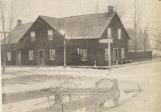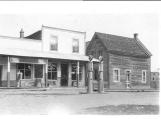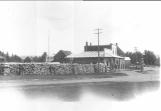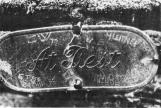1
Born at Penrith, England about 1799, John Dennison held a commission in the British army and had served in the Peninsular war and in India under a commanding officer named Sir Charles Stapleton Cotton, Viscount of Combermere Abbey in Cheshire and senior officer, in the wars mentioned. In 1821, Captain Dennison married Anne Sanderson of Edinburgh, Scotland. At the time he was engaged in the management of the family distillery and brewing business.In 1933 the Dennison family, including children Mary, Elizabeth and John Jr. emigrated to Canada and settled in Quebec City. Here the couple had two more children, Henry and Anne.
In the rebellion of 1831 Dennison distinguished himself in military action, achieving the rank of Captain that would carry the rest of his days. At the end the hostilities he and his family moved to Montreal, where he was demobilized about 1839. While living there, Dennisonís wife died and was buried at St. Andrews, Quebec.
3
Some time in 1852, Captain Dennison and his family moved to Ottawa, Ontario where for four years he operated a distillery. Then, upon leaving Ottawa the family made its way up the Ottawa River to Renfrew County where steady immigration was expanding the country. In recognition of his military service, Dennison received a free land grant. The family settled on a narrow section of the Madawaska River where he constructed and operated an Inn, around which grew a sizable settlement bearing the name Dennisonís Bridge.At this time, s government road was under construction between the Ottawa River and Lake Opeongo to the north and west and Dennison hoped to gain a foothold in the area to serve the influx of immigrants expected to fill the free land grants being offered. The 1871 census taken in Renfrew County lists John and Henry Dennison of Combermere, but not their father (Captain Dennison). The family was well established at Combermere with close to 300 acres of land, of which a good percentage was listed as 'improved' or tillable. The two brothers showed their industrious side in that they were listed as having 'two boats and about fifty fathoms of net' as well as showing copious amounts of grain, hay and produce. They had two horses, two fillies, several cattle and swine. Indeed, five cattle and three swine were slaughtered that year and no doubt the carcasses went to feed the men in the numerous lumber camps, which were being opened. All of this was left behind as they began their move north and west.
5
Co-incident with the death of the Viscount Combermere at his home in England in 1865, Daniel Johnson, a merchant, lumberman and land baron, opened a post office in his store at Dennison's Bridge to serve a growing population in the surrounding community. In order to honour Captainís Dennisonís old friend the former commanding officer, it is believe the name of Dennisonís Bridge was dropped in favour of the name Combermere.At this same time, the Dennison family moved its belongings by canoe via an established trading route upstream on the Madawaska - across Bark Lake, Victoria Lake and through a chain of lakes to the Opeongo River and to the a site at the Narrows. At the Narrows, which separate the east and south arms of Lake Opeongo they cleared land, John on the east side and Henry on the west, with the area becoming the site of the Dennison farm.




